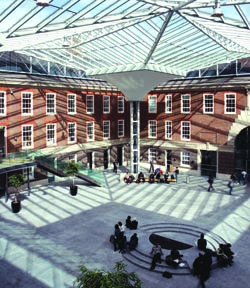- As advancements are made in the realm of assistive listening, no longer are devices being installed solely with the hard of hearing in mind. In an effort to address an increasingly diverse population, facilities are turning to this technology for its multi-lingual features as well.
Traditional uses of ALS products, like this install of Ampertronic induction loops at Middlesex University's Hendon campus in the U.K., are being joined by projects that have more than just the hard of hearing in mind.
"As a nation, and as we are becoming increasingly global, there is demand for systems that will support bilingual hearing assistance or interpretation, and it's increasing," observed Vanessa Jensen, product manager for installed sound at Sennheiser Electronic Corporation. Incorporating an additional channel when it's required is very easy, she added. "If you have a single-channel assistive listening system, and down the line you need to provide a separate language, you can definitely do that with these systems."
Russell Gentner, president of Listen Technologies Corporation, urges those specifying and installing assistive listening products to view the technology as not just a necessary component that fulfills ADA compliance. "Many times, when we use the term 'assistive listening,' many think about it as a product that allows us to comply with ADA, for people who are hearing impaired," he said. These products also offer those without hearing disabilities to access better sound clarity, he underlined. "Maybe they don't need a hearing aid, but they just want to hear what the actors are saying."
The house of worship market is a hotbed for assistive listening, as a growing number of services are offered in multiple languages. "In the church world, it is not a necessity, but there are a large number of churches that understand that they have to provide this technology," said John Fuqua, director of All Pro Sound in Pensacola, FL. "There are also churches that are in transient populations, and they need to have a translation system. The contractor and designer need to know this technology so that you can express to the client that this technology is available."
Performing arts centers, educational facilities, and government facilities continue to employ the technology as well. Mobile assistive listening devices have opened up the opportunity for other applications, such as factory tours, Gentner pointed out. And for noisy environments-such as museums, where audio-equipped exhibits compete with one another for the visitor's ear-assistive listening offers the potential to minimize the din.
Fuqua noted that assistive listening devices can also be used as another way to produce a signal. He illustrated an installation project his company executed for the Blue Angels-the U.S. Navy's flight demonstration team, where repeaters were placed down the flight line, for about 600 feet. "It's just picking up that signal and sending it on down," he explained. "It's broadcasting a signal into a small system that is powered on the tower, and that is broadcast out. Not only are they using it for ALS; they are using it for other means to produce signals."
This is especially practical in applications where overflow is required, but not all the time. "Let's say you have an overflow situation that you don't have very often, but today, you need to get a signal to a room that is maybe 100 feet away, and you don't really have a means of getting a signal there," Fuqua described. "If you have an ALS system, chances are you can use that, come out of that system and go into the PA in the overflow room and distribute that signal."
As the number of assistive listening applications continues to grow, manufacturers are endeavoring to render the product more user-friendly and easier to install. "Because more and more people are using it for the right reasons, we've had to improve the audio quality, the noise performance," Gentner said. "We've needed to make products that have less interference. One of Listen's focuses is to continue to go down the path of improving performance and features, while actually making it easier for everybody when they specify, install, and use the product."
Fuqua observed that the number of assistive listening manufacturers has contributed to the improvement of the technology, in addition to lowering costs. "It was relatively new technology in the early to mid nineties. There were fewer manufacturers in it and less equipment available, and the cost was quite high," he said. "Now there are several manufacturers producing products, and it's brought the cost down. As well, the technology has gotten better, so it's an easier system to install."
Systems have improved so they are less susceptible to environmental interference, such as that created by lighting. "The overall introduction of new carrier frequencies and new systems that move away from the lower carrier frequency systems that were problematic due to the energy efficient lighting being introduced in the early '90s, and the interference that was a result of that," Jensen said.
At Sennheiser, the product development team focuses on infrared systems. "Sennheiser offers the infrared assistive listening system, and overall we feel that those are easier to implement than an RF-based system because you don't have to worry about as much coordination if you are using multiple systems in one facility," Jensen explained.
